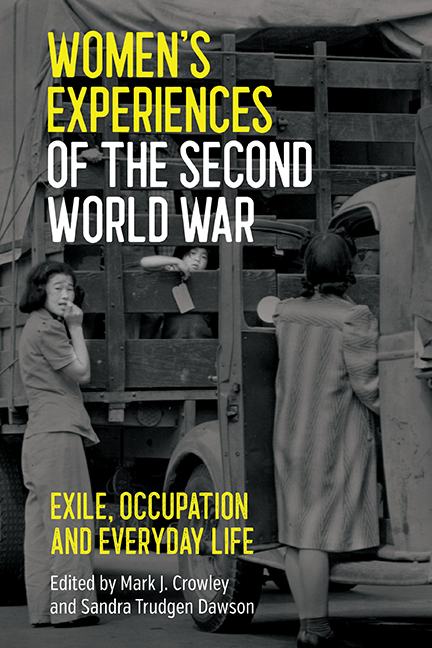Book contents
- Frontmatter
- Dedication
- Contents
- List of Illustrations
- List of Contributors
- Acknowledgements
- List of Abbreviations
- Introduction: Women’s Experiences of the Second World War: Exile, Occupation and Everyday Life
- Part One Living in Exile and under Wartime Occupation
- Part Two Living with Wartime Occupiers
- Part Three Everyday Life at Home and on the Battle Front
- Index
2 - Memories of Exile: An Alsatian Woman in German Occupied Alsace, 1939–1945
Published online by Cambridge University Press: 03 June 2021
- Frontmatter
- Dedication
- Contents
- List of Illustrations
- List of Contributors
- Acknowledgements
- List of Abbreviations
- Introduction: Women’s Experiences of the Second World War: Exile, Occupation and Everyday Life
- Part One Living in Exile and under Wartime Occupation
- Part Two Living with Wartime Occupiers
- Part Three Everyday Life at Home and on the Battle Front
- Index
Summary
Few historical events have reverberated as fully in modern European culture as the Second World War. With the passing of the generation that experienced the conflict, direct memory is fading. Nevertheless, the communal remembrance of the War continues to reverberate in twenty-first century European culture. The countless anniversaries, tributes, and other acts of commemoration taking place are attempts to establish a link between a fast-changing contemporary world and a common past. Many European nations have used the war years to re-define themselves in the post-war period. In France, for example, the collective memory of the war revolved for a long time around resistance. This is a collective memory that has been challenged and undermined by questions about collaboration which began to air after 1968. Since the 2000s, French scholars of the war have focused on the German control and occupation of Eastern France including Alsace. This is a unique area because of both the geographical proximity to and the shared history with Germany. While Strasbourg remained a free city, the population spoke German.
In 1871, during the Franco-Prussian War, the German army occupied Alsace. Alsatian, French, and German cultures clashed under the occupation. Approximately three quarters of all Alsatians were Catholic and pro-French, and the Protestant minorities were pro-German. The majority of Alsatians, including some middle-class Protestants, did not wish to be ruled by Germans. Many Alsatian Catholics believed that, on the condition that the French repented for their sins, the Virgin Mary would actively participate in French affairs. Sins in the 1870s, according to these French/Catholics, included revolution, republicanism, absence of fidelity to the Church, and a failure to support the Pope. They believed the Prussian victory over France was the penalty for these sins. According to T. A. Keselman, author of Miracles and Prophesies in Nineteenth-Century France, in October 1872, pilgrims from Metz and Strasbourg carrying Alsatian banners led a procession to Lourdes where they asked the Virgin to return Alsace-Lorraine to France. The following year another group of pilgrims went to Paray-le Monial to the Church of Sacré-Coeur carrying a banner with the caption, ‘Sacred Heart of Jesus, redeem France. Give us back our homeland!’ At that time, most Alsatians were antagonistic to the Germans.
- Type
- Chapter
- Information
- Women's Experiences of the Second World WarExile, Occupation and Everyday Life, pp. 29 - 42Publisher: Boydell & BrewerPrint publication year: 2021

